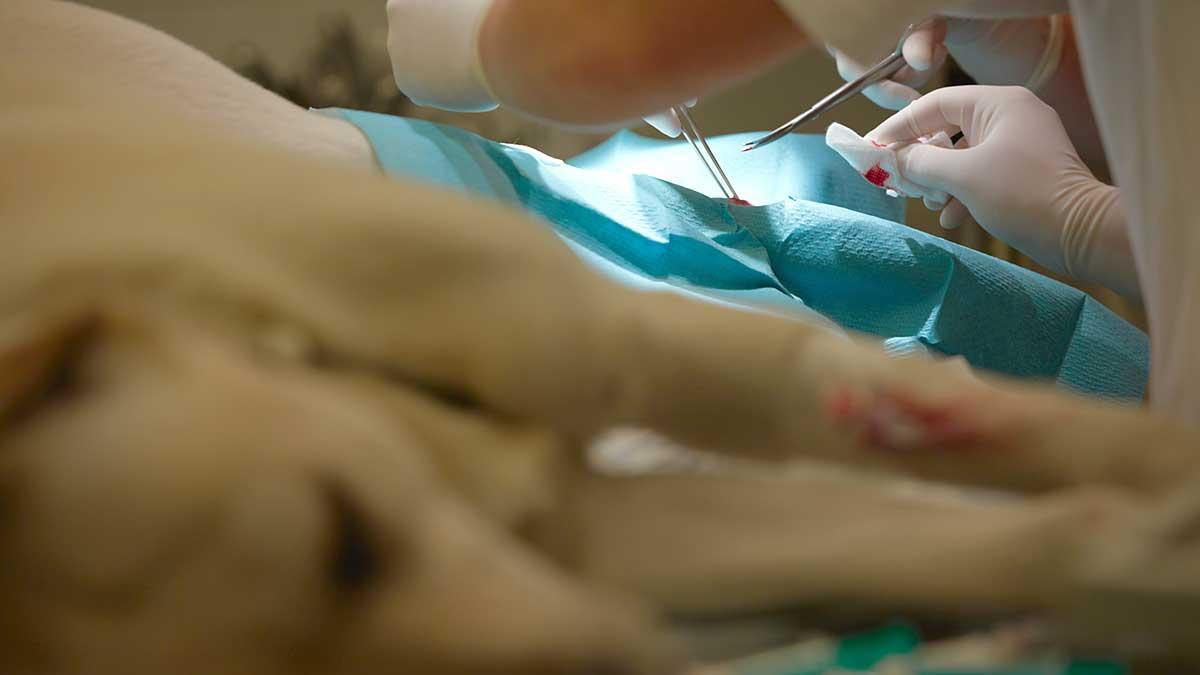
Our furry companions bring joy, love, and an abundance of playful energy into our lives. However, just like humans, dogs can experience orthopedic issues that affect their mobility and overall well-being. Orthopedic surgery plays a vital role in addressing and resolving these conditions, allowing our four-legged friends to regain their zest for life. Here's how orthopedic surgery can help restore mobility and enhance the quality of life for our beloved canine companions.
Understanding Cruciate Ligament Tears
One of the most prevalent orthopedic issues in dogs is a cruciate ligament tear, specifically the cranial cruciate ligament (CCL). The CCL is crucial for providing stability to the knee joint. When it becomes torn or ruptured, it can lead to pain, lameness, and difficulty in walking. Certain breeds, overweight doggos, and those engaged in rigorous physical activities are more susceptible to this injury.
The Role of Orthopedic Surgery
Ortho surgery, such as a cranial cruciate ligament repair, is often recommended to address the instability caused by ligament tears. The primary goal of this procedure is to restore joint stability, relieve pain, and improve your pup’s mobility and overall quality of life. Medical intervention from a veterinarian orthopedic surgeon helps stabilize the affected joint, allowing the joint to function optimally.
The Benefits of Surgery
Surgery offers a range of benefits for dogs of all shapes with ligament tears. By restoring stability to the knee joint, the surgery reduces pain and discomfort, improving your dog's ability to move freely and engage in physical activities. It can prevent or slow down the progression of degenerative joint disease, enhancing long-term joint health. Additionally, surgical intervention can prevent secondary complications, such as meniscal tears, that may arise due to the instability of the knee joint.
Advanced Surgery
Ortho surgery in veterinary medicine involves repairing broken bones, joints, and torn ligaments through surgical procedures. The goal of these procedures is to realign broken bones and secure them in place using pins or other methods to prevent further movement. This promotes proper healing and recovery.
Expert surgeons utilize surgical techniques to restore damaged or dysfunctional limbs, joints, ligaments, and tendons to their normal or near-normal state whenever possible. This is achieved through the use of various surgical implants such as pins, screws, bone plates, external and internal fixation, casts, splints, bone grafting, and other forms of artificial support systems.
Common Fractures In Dogs
There are various types of fractures that a dog can experience, and each may require a different type of surgery for repair. Bones contain calcium, which makes them both sturdy and vulnerable to damage. Factors such as the age of the pet, overall health, and location of the fracture all impact the severity and complexity of the injury, as well as the necessary course of treatment. The force of the impact is also a crucial consideration when managing orthopedic damage and conditions for dogs.
Hairline Fractures
When bones develop small cracks in their middle, it is known as a hairline fracture. This type of fracture is relatively straightforward and occurs when the bone remains unbroken. Long bones, such as leg bones, are susceptible to hairline fractures. Dogs who suffer from hairline fractures usually only require minimal management, and bone misalignment or displacement is rare. To give an analogy, think of a hairline fracture as a small crack in a piece of lumber. Although the board remains intact, its ability to bear weight is compromised, and it may eventually break.
Multiple-Piece Fractures
When a bone experiences stronger impacts, it can shatter into multiple pieces, resulting in complex fractures that typically necessitate surgical intervention.
Joint Fractures
If a dog suffers a joint fracture, the injury can be particularly severe. This is because joints play a crucial role in movement, and such fractures can result in arthritis even after the bone has fully healed. A dislocated hip joint can be replaced through surgery that utilizes toggle pin fixation.
Open or Compound
When a dog's bone becomes exposed outside of its skin, it is known as an "open" or "compound" fracture. Such fractures can cause serious harm to surrounding tissues, tendons, muscles, nerves, and blood vessels due to sharp bone pieces piercing them. Moreover, the exposed bone is vulnerable to getting dirty and contaminated, leading to severe infections that can endanger your canine companion’s life and limb. Proper and careful care is necessary to resolve such infections.
Preparing for Surgery
Before the surgery, a thorough evaluation of your pet’s overall health is conducted. This may include blood tests, radiographs, and physical examinations. The vet will provide specific pre-operative instructions, which may have your pup fast prior to surgery and temporarily adjust their medication regimen. It's essential for dog owners to communicate any concerns or questions they may have during this preparation phase.
The Surgical Procedure
During the surgery, the vet will make a small incision to access the affected knee joint. Depending on the specific technique chosen, the torn ligament may be repaired using a variety of methods, including suture stabilization techniques or implantation of prosthetic devices. The veterinarian will select the most suitable approach based on your doggo’s condition, size, and lifestyle.
Post-Operative Care and Recovery
Following surgery, your dog will require proper post-operative care and a structured recovery plan. This may include pain management, restricted activity levels, and physical rehabilitation. Dog owners play a crucial role in this process by ensuring that their furry friend follows the prescribed medication schedule, attends follow-up visits, and follows activity restrictions. Gradually, as your doggo heals, a customized rehabilitation program will be implemented to regain strength, flexibility, and mobility.
Long-Term Prognosis and Follow-Up
The long-term prognosis after surgery for a cruciate ligament tear in dogs is generally favorable. With proper post-operative care, rehabilitation, and adherence to activity restrictions, dogs can experience significant improvement in their mobility and quality of life. Regular follow-up visits with the vet will help monitor your pet’s progress, assess joint health, and make any necessary adjustments to the recovery plan.
Preventive Measures
While ortho surgery can effectively address cruciate ligament tears, it's always better to prevent such injuries whenever possible. Maintaining a healthy weight, providing regular exercise, and avoiding excessive strain on the joints can help reduce the risk of ligament tears. Additionally, using proper techniques when engaging in physical activities with your dog, such as using a harness instead of a collar for leash walks, can minimize the stress on the joints.
Types Of Orthopedic Surgery Performed At Laveen Veterinary Center
In the event of a fracture or orthopedic injury, rest assured that there are various surgical or management solutions available. At Laveen Vet Center, our team is equipped with the expertise to determine the most suitable treatment for your pet. We'll consider multiple options and prioritize safe and effective surgical techniques, even if the condition seems severe. This may include the use of minimally invasive procedures to minimize discomfort and accelerate healing.
TPLO Surgery
We offer standard orthopedic procedures such as TPLO surgery and extracapsular repair for all breeds of dogs. TPLO surgery is our most commonly performed orthopedic procedure that stabilizes the knee by leveling the tibial plateau. It was developed to change the biomechanics of the knee so that your dog no longer needs the damaged CrCL (ACL or CCL). Our skilled surgeons achieve this by reorienting the tibia, the bone that makes up the lower portion of the knee joint. Dogs have a sloped tibia bone, which can cause the femur to slide off the back of the tibia when they bear weight on the limb if the CrCL is ruptured or damaged. A TPLO surgery levels this slope, preventing instability within the joint and allowing your dog to comfortably bear weight on the limb.
Patellar Luxation
Medial patellar luxation is a painful orthopedic condition that causes misalignment and dislocation of the kneecap in both dogs and cats. This condition can lead to chronic lameness and arthritis. In some smaller dog breeds, such as Yorkshire Terriers, patellar luxation can occur genetically, and it can also happen along with cruciate ligament ruptures. Although luxating patellas often affect both legs, the procedure to correct it is routine and has a high success rate.
Consulting with a Vet
If you suspect that your dog may be experiencing orthopedic issues or if you have any concerns about their mobility, it's important to consult with a veterinarian. They will conduct a thorough examination, potentially including imaging tests, to diagnose the problem and recommend the most appropriate course of action. Early detection and intervention can lead to more successful outcomes and prevent further complications.
Ortho surgery plays a crucial role in addressing the most common orthopedic condition in large dogs and smaller dogs: cruciate ligament tears. By restoring joint stability, relieving pain, and improving mobility, this surgery can significantly enhance the quality of life for our beloved canine companions. Remember, early detection, proper preparation, and diligent post-operative care are key to a successful recovery. If you suspect any orthopedic issues in your dog, don't hesitate to reach out to your vet. Together, we can ensure our furry friends enjoy a happy, active, and pain-free life.
Contact Laveen Veterinary Center Today
Are you searching for top-notch veterinary orthopedic surgeons in Laveen, AZ, and the South Phoenix area? Look no further than our highly skilled and dedicated staff. Our veterinarians possess extensive experience performing orthopedic surgeries and boast more collective expertise than the majority of veterinary clinics in the area. Give us a chance to demonstrate our expertise and passion for animal care.
Contact us today at (602)559-9600 to schedule an initial appointment and learn more about our orthopedic pet services. You can also send us a message by completing our online contact form. Together we will develop a plan to help your dog recover from their orthopedic problems and maintain a healthy lifestyle for as long as possible. Call today!


